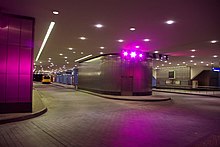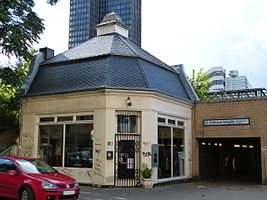Berlin Rathaus Steglitz station
| Berlin City Hall Steglitz | |
|---|---|
|
East exit of the S-Bahn station to Berlinickestrasse with the listed sales pavilion from 1910. The high-rise of the Steglitzer Kreisel can be seen behind the roof .
|
|
| Data | |
| Operating point type | Stop , former train station |
| Platform tracks | 2 |
| abbreviation | BRST |
| IBNR | 8089036 |
| Price range | 4th |
| opening | June 13, 1839 |
| Website URL | s-bahn-berlin.de |
| Profile on Bahnhof.de | Rathaus_Steglitz |
| location | |
| City / municipality | Berlin |
| Place / district | Steglitz |
| country | Berlin |
| Country | Germany |
| Coordinates | 52 ° 27 '22 " N , 13 ° 19' 18" E |
| Railway lines | |
|
|
| Railway stations in Berlin | |
As station Rathaus Steglitz one to the station of the Deutsche Bahn and underground station of the BVG in Berlin district of Steglitz of the borough of Steglitz-Zehlendorf referred. Both stations are located diagonally across from Steglitz Town Hall , which gives it its name .
Today's S-Bahn station on the S1 line on the former "main line" from Berlin to Potsdam (later Berlin – Magdeburg line ) is one of the oldest train stations in Berlin and has been in operation since 1839 with interruptions.
S-Bahn station
The Stegelitz station (since around 1870: Steglitz ) on the main line to Potsdam was opened as one of the first German stations on June 13, 1839 (see History of the Railway in Germany ), closed again in 1845 and reopened in 1864. After the railway accident in Steglitz in 1883, the tracks were moved to an elevated position between 1884 and 1886 and the station was rebuilt accordingly. The station name from 1920 was Berlin-Steglitz .
The new Wannseebahn , which opened in October 1891, was electrified with 750 V direct voltage ( traction current ) from the Potsdam train station / Wannseebahnhof via the Steglitz train station to the Zehlendorf train station . From 1900 to 1902 this enabled a trial operation with electric trains in suburban traffic from Potsdam train station via Steglitz to Zehlendorf. On the Wannsee Railway, regular electrical operation did not begin until May 1933 towards the end of the " Great Electrification ".
The train station is located directly next to the federal motorway 103 (Westtangente). In 1965, the old station building from 1873 had to give way to the construction of the motorway. 1910 constructed building at the eastern entrance have been preserved Albrechtstraße corner Berlinickestraße . They are under monument protection . As a replacement for the office space in the station building, the Deutsche Reichsbahn received office space on the ground floor of the building at Berlinickestraße 13 (corner of Mittelstraße ), which until the beginning of the 1990s was also used to sell long-distance tickets.
The station is directly connected to the underground station by a tunnel. The S-Bahn station has an elevator so that it is barrier-free .
In September 1980, as on many routes in West Berlin , there were no more S-Bahn trains on the Wannsee Railway after the second Reichsbahn strike. On February 1, 1985, the BVG reopened the route. From the end of 1988 to August 1990, the S-Bahn was temporarily relocated to the freight tracks (former long-distance train tracks to the Potsdam train station), and two temporary outer platforms were built. Adapted to the U-Bahn station, the S-Bahn station has been called Rathaus Steglitz since May 31, 1992 .
Subway station

The underground station was opened in connection with the extension of the U9 line from Walther-Schreiber-Platz to Rathaus Steglitz on September 30, 1974. The train station, which is designated Rzu in the BVG train station directory , has walking and escalators as well as a lift and is therefore barrier-free .
The Senate Administration also had a second tunnel built for a planned U10 . For example, a two-story tunnel for the U9 and U10 was built from the Bundesallee / Rheinstrasse intersection through Schloßstrasse to Hermann-Ehlers-Platz. The U10 was originally supposed to lead via Klinikum Steglitz (today: Campus Benjamin Franklin of the Charité ) to Drakestrasse (Wiesenbaude) . The plans for the U10 were given high priority until 1984, but then lost importance because of the parallel traffic to the S-Bahn and were finally discontinued in 1993.
The tracks actually intended for the U9 make a big swing at Rathaus Steglitz towards the S-Bahn station. The U9 has been using the tracks of the U10 with a central platform since it opened . The reason is that the space for the necessary sweeping system would have been behind the tunnel to the S-Bahn station, which would have required a permit from the Deutsche Reichsbahn. After the BVG took over the operation of the S-Bahn in West Berlin in 1984, the tunnel under the S-Bahn route could be extended. The work was carried out while maintaining the S-Bahn service in 1989 and 1990. For this purpose, lateral temporary platforms for the S-Bahn were built on the freight tracks - with the approval of the Deutsche Reichsbahn. At the same time, higher bridges were built for Albrechtstrasse so that double-deck buses could also use the underpass.
The side platforms for the U9 are in the shell and served as a senate warehouse until the political change . a. for emergency beds. By using the U10 platform, the transfer routes to the S-Bahn are considerably longer. An extension of the U9 to Lankwitz remains a long-term plan, the construction of the route to Drakestrasse is no longer independent of the realization of the U10.
The BVG also had a large underpass structure built underground so that there are direct access routes to the Steglitz roundabout and the Steglitz town hall . As was customary at the time, the Senate architect Rainer Rümmler designed the concept for the station. Rümmler used large wall elements in red and silver, the station logo "Rathaus Steglitz" dominated the design. On the ceiling there are oversized circular elements - corresponding to the style of the 1970s - that serve as covers for the station lamps. In the pedestrian walkway, a large sheet steel sculpture of the Hellhound Cerberus from Greco - Roman mythology and designed by Waldemar Grzimek watches over . In addition, there is an installation on the north-east wall with the lettering of all world metropolises that had a subway at the time the station opened in 1974. The underpass structure is perceived by many as confusing due to the long transfer routes, which was also the reason why parts of it were closed by the BVG as early as 1988. For example, there used to be a third access to the operating platform, which was also closed (in November 2018 it was provisionally reopened as a replacement for the escalator that was closed during the renovation work).
In 2005, parts of the underground station were renovated and the Das Schloss shopping center opened in March 2006 . It was built next to the old Steglitz town hall and has direct access routes to the underground station.
For 2013, the BVG planned a basic overhaul and the barrier-free expansion of the station. 23.2 million euros are to be invested for this. In the meantime, the renovation was postponed and started in 2015.
Connection

The station is served by the S1 line of the S-Bahn and the U9 line of the subway. Rathaus Steglitz is also the most important bus transfer hub in the southwest of Berlin. At the stops in the lock road in the road and in the Albrecht Kuhligkshofstraße keep the bus lines M85 X83 170 186 188 282 283 284 285 380 N9 and N88 M48, M82,,,,,,,,,,,. For easier orientation, the stops are arranged according to nine positions, with positions 6, 7 and 8 in the bus station in the Steglitz roundabout .
Steglitz freight yard

On the east side of the Gleistrasse, on the former tracks of the main line, the Steglitz freight station stretched between Albrechtstrasse and the Feuerbach Bridge .
Web links
- Entries in the Berlin State Monument List: Ensemble of S-Bahn station, pavilion and tunnel ;S-Bahn station
- BVG map of the train station (PDF; 145 kB)
- More pictures on untergrundbahn.de
Individual evidence
- ↑ Station price list 2020. In: Deutsche Bahn. Deutsche Bahn, January 1, 2020, accessed on July 11, 2020 .
- ↑ Query of the course book route 200.1 at Deutsche Bahn.
- ↑ Sebastian Höhn: No train will come . In: Berliner Zeitung . June 9, 2011 ( berliner-zeitung.de ).
- ^ U Bahn Berlin - U10 tunnel hike + CII special trip. UndergroundBerlin, September 7, 2014, accessed April 9, 2016 .
- ↑ BVG supervisory board praises very good operating result. Berliner Verkehrsbetriebe, April 24, 2013, accessed on April 25, 2013 .




